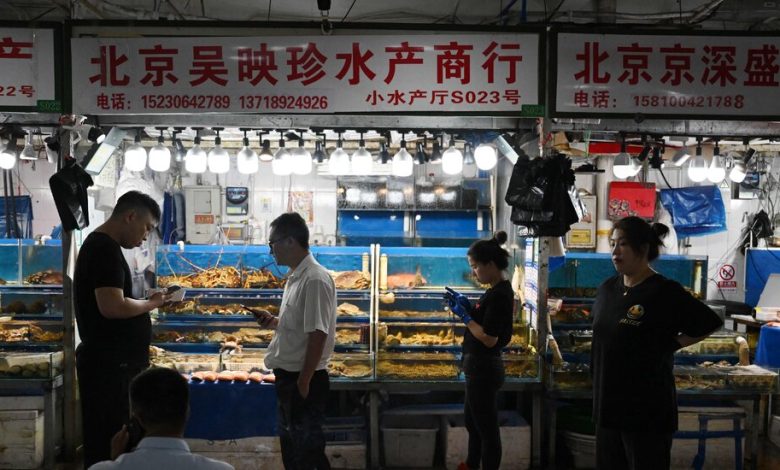Seafood Is Safe After Fukushima Water Dump, but Some Won’t Eat It

Seafood is having a bad week in East Asia, which is bad news for a region where it’s a major part of the diet.
Experts say Japan’s discharge into the ocean of treated radioactive wastewater from the ruined Fukushima nuclear power plant, which began on Thursday, does not and will not pose health risks to people who eat seafood. But even though the scientific evidence bears that out, not everyone is convinced.
On Thursday, the Chinese government widened a ban on seafood imports to include all of Japan instead of only some regions. The wastewater release has been heavily politicized and fueled deep anxiety over seafood in both China and South Korea, leaving some wondering whether sushi, sashimi and other products were still safe.
At Noryangjin Fish Market in Seoul on Friday, fish vending associations had put up banners urging consumers to not give in to paranoia.
“Our seafood is safe!” one read. “Let’s consume with confidence!”
“Don’t create anxiety with unsubstantiated myths and exaggerations!” said another.
Yoo Jae-bong, 52, who was trying to sell fresh halibut, croaker and sea bream at the market, the city’s largest, said there had been a rush of customers the day before the water was released.
“Then it died down,” he said. “There’s a lot of fear in the air.”
The wastewater released into the Pacific Ocean on Thursday is the first tranche of more than a million tons that is scheduled to be discharged over the next 30 years. The Japanese government and the electric utility that operated the plant have promised that the water is safe for humans.
International experts agree. The United Nations’ nuclear watchdog has said contamination of seafood outside the plant’s direct vicinity will be “significantly below any public health concern.” Independent scientists also say that Japan’s decision makes technical sense; that similar releases have occurred around the world without incident; and that the extra radiation will be tiny relative to what’s already in the ocean.
But ever since Japan announced its discharge plan two years ago, the issue has been contentious inside and outside the country — particularly in South Korea, a former Japanese colony where anti-Japanese sentiment tends to run high.
In those two years, the Japanese authorities and the international scientific community have failed to effectively communicate the science around the discharge and explain why the risks to public health are exceedingly low, said Nigel Marks, a physics and astronomy professor at Curtin University in Australia. As a result, he said, misinformation has filled the void and undermined public confidence in Japan’s plans.
“Nature abhors a vacuum, and everyone just poured in, and some of it stuck,” Mr. Marks said by phone on Friday.
“I’m sure they’d love to run it all over again and do it better,” he said, referring to the authorities.
Hirokazu Matsuno, a spokesman for the Japanese government, told reporters this week that it had “thoroughly tried to explain” the issue to the international community “based on scientific grounds and with a high degree of transparency.”
Ahead of the initial wastewater release on Thursday, several Chinese sushi brands either declared that their ingredients were not from Japan or promised to get rid of any that were. The Chinese government has fanned outrage in recent weeks over Japan’s plan to release the treated water, and tensions between the two countries rose further after the signing last week of a trilateral security pact between Japan, South Korea and the United States.
In Seoul, it has been common to see protesters holding signs showing dead fish and the radiation symbol.
This week, regional anxiety around fish and seafood, and the arguments for why it is still perfectly safe to eat, have gone into overdrive.
One sign of the anxiety emerged Thursday when the Seoul police detained 16 college students who had tried to barge into the building that houses the Japanese Embassy. Before they were taken away for questioning, the students unfurled banners and shouted slogans protesting the Fukushima water discharge.
In another indication of worry, there was plenty of fresh fish for sale at Noryangjin Fish Market on Friday — mackerel, octopus and sea bass, all swimming in tanks — but the vast concourse was so empty of people that a reporter could easily count the shoppers. Most fishmongers at the market, where the seafood is mainly from Korean waters, were looking at their phones or staring into space.
In Hong Kong, a Chinese territory where the local government has banned seafood from some but not all Japanese prefectures, the topic of seafood safety has been popular on social media this week.
Ivan Kwai, the manager of Kyouichi, a sushi and sashimi restaurant in Hong Kong’s Quarry Bay district, said on Friday that bookings had recently dropped by half.
“People have lost confidence,” Mr. Kwai, 60, said as he tapped a finger over his booking ledger. He added that he planned to replace his supply of Japanese products with Norwegian salmon, Canadian sea urchins and other imports.
As of Friday, it was unclear what impact anti-seafood sentiment would have on Japan’s exports in the longer term. But early data is not encouraging. China’s state-run news media said this week that imports of seafood products from Japan in July had fallen 29 percent compared with the same month a year earlier, a drop that Japanese news reports have linked to checks on seafood coming from Japan for traces of radiation.
If the negative sentiment sticks, it could potentially have a big impact on Japan’s economy. Last year, the country’s seafood exports were worth 387 billion yen, or about $2.6 billion, official data shows. Sales to China and Hong Kong accounted for more than 40 percent of the total.
That helps explain why, on Wednesday, Japan’s economic minister, Yasutoshi Nishimura, ate sashimi in Tokyo as news cameras rolled. “It’s really the best!” he said.
Not everyone in East Asia is bothered by the Fukushima wastewater release, of course.
At a branch of Umimachidon, a Japanese chain restaurant in Hong Kong that is famous for its sashimi rice bowl, a line formed during lunchtime on Friday.
“I’m not worried” about contamination, said Edward Yeung, 30, as he stood in line with his family. “I want to eat as much as I can before the price goes up.”
Siyi Zhao and Choe Sang-Hun contributed reporting.





